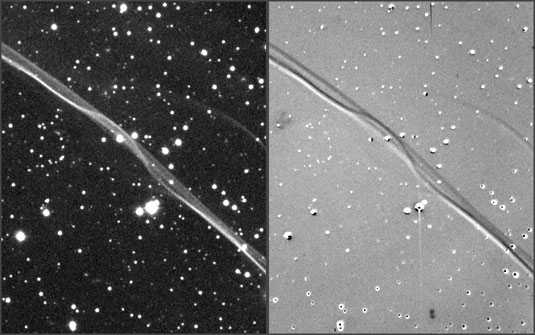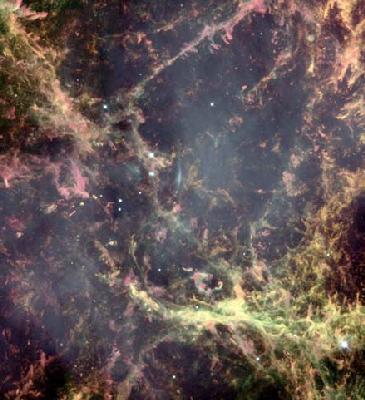No bright supernovae have exploded in the Milky Way Galaxy since the invention of the telescope in 1610. However, at least five supernovae that must have occurred within our galaxy were recorded in various chronicles and writings from medieval times into the Renaissance.
An article in the February 2004 issue of Astronomy (“Star light, star bright”) discusses the supernova of 1006. Here is a list of bright supernovae that have been witnessed and recorded throughout history.
For a full exploration of the historical record and what modern astronomers can discern from it, see Historical Supernovae and their Remnants by F. Richard Stephenson and David A. Green (Oxford University Press, 2002).
Supernovae (all dates are A.D.)
1006
The supernova of 1006 first appeared May 1st in the constellation Lupus the Wolf. It was noted in records from China, Japan, the Arab dominions, and Europe. As the magazine story notes, it reached a peak apparent brightness of -7.5 magnitude and remained visible for about two years. Its behavior suggests a Type Ia supernova, produced when a white dwarf member of a close binary star system accretes gas from its companion and grows in mass to the point where it explodes.
The supernova of 1006 first appeared May 1st in the constellation Lupus the Wolf. It was noted in records from China, Japan, the Arab dominions, and Europe. As the magazine story notes, it reached a peak apparent brightness of -7.5 magnitude and remained visible for about two years. Its behavior suggests a Type Ia supernova, produced when a white dwarf member of a close binary star system accretes gas from its companion and grows in mass to the point where it explodes.
1054
This supernova appeared July 4th in the constellation Taurus the Bull. It was noted in records from China and Japan but not, apparently, from Europe or the Arab regions. A pictograph at Chaco Canyon, New Mexico, however, may record its appearance as seen by Anasazi Indian skywatchers. The supernova reached a peak apparent brightness of about -3.5 magnitude and remained visible for nearly two years. It was probably a Type II supernova, the kind that forms when a single massive star explodes, leaving a neutron star as its gravestone. The supernova’s gaseous remnant is visible today in backyard telescopes as the Crab Nebula in Taurus.
This supernova appeared July 4th in the constellation Taurus the Bull. It was noted in records from China and Japan but not, apparently, from Europe or the Arab regions. A pictograph at Chaco Canyon, New Mexico, however, may record its appearance as seen by Anasazi Indian skywatchers. The supernova reached a peak apparent brightness of about -3.5 magnitude and remained visible for nearly two years. It was probably a Type II supernova, the kind that forms when a single massive star explodes, leaving a neutron star as its gravestone. The supernova’s gaseous remnant is visible today in backyard telescopes as the Crab Nebula in Taurus.
1181
Discovered August 6th in the constellation Cassiopeia the Queen, this supernova was noted in records from China and Japan. Its maximum brightness remains uncertain, but it probably shone at zero magnitude or slightly brighter. The supernova’s type is unknown, but it remained visible for about six months. The radio source 3C58 is believed to be the remnant of the supernova; a deep photograph shows a few faint filaments that may be the gaseous remnant.
Discovered August 6th in the constellation Cassiopeia the Queen, this supernova was noted in records from China and Japan. Its maximum brightness remains uncertain, but it probably shone at zero magnitude or slightly brighter. The supernova’s type is unknown, but it remained visible for about six months. The radio source 3C58 is believed to be the remnant of the supernova; a deep photograph shows a few faint filaments that may be the gaseous remnant.
1572
The 1572 supernova was discovered November 6th in the constellation Cassiopeia the Queen. It was noted in records from China, Korea, and Europe, where the supernova’s position and declining brightness were observed with high accuracy by Tycho Brahe. (The supernova is often termed “Tycho’s supernova.”) It reached a peak brightness of about -4 magnitude and remained visible until March 1574. It was probably a Type I supernova, although the sub-type is uncertain. The remnant is the radio source 3C10.
The 1572 supernova was discovered November 6th in the constellation Cassiopeia the Queen. It was noted in records from China, Korea, and Europe, where the supernova’s position and declining brightness were observed with high accuracy by Tycho Brahe. (The supernova is often termed “Tycho’s supernova.”) It reached a peak brightness of about -4 magnitude and remained visible until March 1574. It was probably a Type I supernova, although the sub-type is uncertain. The remnant is the radio source 3C10.
1604
Another supernova was discovered on October 13, 1604, in Ophiuchus the Serpent-bearer. It was noted in records from China, Korea, and Europe, where it attracted much attention. The supernova is often called Kepler’s supernova, because he carefully measured its position and tracked the changes in brightness. It was discovered about a month before reaching peak brightness, which was roughly -3 magnitude, but its type is undetermined. The supernova was never visible in daylight, and it faded from view in October 1605. The supernova’s remnant is the radio source 3C358.
Another supernova was discovered on October 13, 1604, in Ophiuchus the Serpent-bearer. It was noted in records from China, Korea, and Europe, where it attracted much attention. The supernova is often called Kepler’s supernova, because he carefully measured its position and tracked the changes in brightness. It was discovered about a month before reaching peak brightness, which was roughly -3 magnitude, but its type is undetermined. The supernova was never visible in daylight, and it faded from view in October 1605. The supernova’s remnant is the radio source 3C358.
Possible supernovae
Asian records mention “guest stars” that were clearly not comets) in the following years, all A.D.: 70, 185, 369, 386, 393, and 837 (two guest stars). “Guest star” was the general term used in Chinese astronomy for novae and supernovae, also for comets in some records. Astronomers can distinguish among these only where the description is unambiguous and where the observational record is good enough to create a light curve — or in cases where a clear-cut supernova remnant is found at the location.
Asian records mention “guest stars” that were clearly not comets) in the following years, all A.D.: 70, 185, 369, 386, 393, and 837 (two guest stars). “Guest star” was the general term used in Chinese astronomy for novae and supernovae, also for comets in some records. Astronomers can distinguish among these only where the description is unambiguous and where the observational record is good enough to create a light curve — or in cases where a clear-cut supernova remnant is found at the location.
On these grounds, astronomers suspect that the guest stars of 185 and 393 were likely supernovae. The others were either too ambiguous to tell or were ordinary novae.











